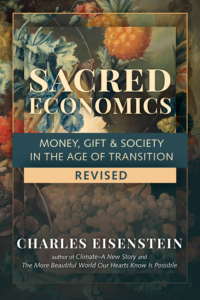Climate — A New Story
Chapters
Chapter 5: Carbon: The Ecosystems View
The Emissions Obsession
I have gone into the carbon accounting frame in order to establish that local, intimate, participatory care “works” even within greenhouse gas logic. In so doing, however, I have dabbled in a dangerous reductionism, subsuming a dizzying array of complex ecological interactions under a single metric: units of carbon. In doing so, I risk implying, “What matters about these ecosystems is the amount of carbon they sequester,” and affirming carbon as a valid proxy for ecological well-being. Thus I participate in the ubiquitous equation of “green” or “sustainable” with low carbon.
The crucial role of living systems in maintaining climate stability presents us with good news and bad news. The good news is that our world can survive, that it can potentially adapt to higher levels of greenhouse gases. The bad news is that the ecosystems that can do this are in steep decline all over the world. That means, given positive feedback loops that are already releasing large amounts of carbon and methane from nonhuman sources, climate instability will continue to worsen even if we cut fossil fuel use to zero, unless we also heal and protect the forests, mangroves, seagrass, and so on.
One challenge that climate change skeptics sometimes pose is that CO2 levels and temperatures were much higher in past epochs than today, and the planet did just fine. The standard rejoinder is that never before have CO2 levels risen this abruptly. Whether or not that is true, I think it overlooks a more important issue: where did the biosphere’s historical resiliency come from? It came from healthy living ecosystems. Life creates the conditions for life, and the modern era has been an era of unprecedented death.
The climate skeptics also state an important, albeit partial, truth when they claim that increased atmospheric CO2 will result in more plant growth and higher CO2 uptake. Carbon uptake has indeed been faster than expected, increasing in ten years from 40 percent to 50 percent of fossil fuel emissions.[18] We might be fine—if it weren’t for the fact that some quarter to a third of the planet’s land surface has been severely devegetated, and most of the rest compromised by human activity. Deserts, monocrop agriculture, and pavement don’t sequester much carbon.
Ecosystem disruption has turned many areas from carbon sinks into carbon sources. Likewise, the skeptics are right that CO2 levels were several times higher millions of years ago, and that Earth’s climate undergoes natural fluctuations. Tragically, though, habitat degradation, pollution, development, mining, wetlands draining, overfishing, extermination of predators, and so forth have created conditions where plants and the rest of life are no longer able to fully exercise their capacity to maintain planetary dynamic resiliency. Gaia has the capacity to self-regulate—a capacity we are destroying.
Given growing awareness of the crucial role of forests and other ecosystems in regulating climate, as well as the potential that I will discuss later of regenerative agriculture to sequester massive amounts of carbon very quickly (and, more importantly in my view, restore the water cycle), why is the policy conversation so focused on emissions?
Here are a few reasons:
First and most simply, it is a lot easier to measure or estimate fossil fuel emissions than it is emissions from land use changes. While measurements of biomass have improved with new technology and the accumulation of research, they still vary widely from place to place and study to study. In our present political culture, policymakers, treaty negotiators, and regulators need quantitative measures to define goals, agreements, and rules based on a “carbon budget.” Emissions therefore fit much more easily into the political culture.
Biosequestration is even harder to measure than biomass. I asked a researcher, Oswald Schmitz of Yale University, why there is so little hard data on carbon sequestration. His explanation was simple: it is much easier to measure and calculate aboveground carbon storage than it is to measure it in soil. This illustrates a general principle: when we rely on metrics to make policy, it becomes biased toward the things that we choose to measure, that we are able to measure, and that are intrinsically amenable to measurement. Furthermore, what gets ignored often corresponds to cultural blindspots and prevailing social, material, and economic practices.
Generally speaking, it is very difficult to measure the total carbon, let alone the sequestration rate, of soil. Most assays include only the first 30 centimeters or 1 meter, yet deep-rooted grasses and other vegetation can store carbon much more deeply than that.[19] Then there is the matter of the molecular composition of the soil organic matter, which determines how long it stays stored in the ground before reentering the carbon cycle. This time period also depends on local conditions, the microclimate, the composition of soil biota, and so forth.
Biological carbon fluxes (and those of other greenhouse gas) do not lend themselves easily to climate modeling compared to emissions. The more climate is understood to interact significantly with life, the more difficult it is to model. Fluid dynamics, the flow of heat and air and currents, is relatively easy to simulate on a computer. That is not true of the processes of life: the way virgin forests maintain microclimates better than tree farms, the role of cloud-seeding bacteria, the effect of earthworms on populations of soil methanotrophs, the effect of whales on ocean nutrient mixing and hence plankton biomass. Such things are hard to model, or indeed even to understand, without decades of close study. We tend to focus on what is amenable to our most familiar tools.
The focus on emissions rests comfortably in the predominant geomechanical view of the planet, which sees Earth as a complicated machine rather than a living organism.
Modern reductionistic methods are well adapted to dealing with complicated (as opposed to complex) systems. In a complicated system like an automobile or computer, though there may be many variables, the variables are more or less independent. If the system isn’t working, you can troubleshoot it by isolating and testing the variables one by one. You can also generate predictable macroscopic effects through controlling one or a limited number of variables. Complicated systems are therefore amenable to a piecemeal approach to problem-solving. The whole is equal to the sum of the parts, and causal relationships are generally linear. To understand and manage a large, complicated system, you divide it up into lots of pieces and assign a team to work on each piece. The entire structure of academia reflects this approach, with its division into relatively autonomous disciplines and subdisciplines.
The top-down control-based approach that works for complicated systems fails miserably to manage complex systems. In a complex system, variables are dependent, causal relationships are nonlinear, and a small change to one element of the system can dramatically alter the whole. No part can be understood in isolation, but only with reference to an extended web of relationships to other parts. In complex systems, the whole is greater than the sum of the parts; therefore any reductionistic analysis of the system will fail to understand it, and attempts to isolate and alter variables will generate unintended and unpredictable consequences.
Bodies, ecosystems, genomes, societies, and the planet are complex systems. It is tempting to view them otherwise—as extremely complicated machines—because then we can apply our familiar methods of top-down problem-solving and feel like we are in control of the situation. The epitome of this illusion is war thinking, as described earlier in this book, and it extends to every technology of control, from border walls to antibiotic drugs to concrete waterways. Each ends up generating awful unintended consequences, usually including the very opposite of what it was attempting to control (immigration, disease, flooding).
Any narrative, like the Standard Narrative of climate change, is a lens that illuminates some things and obscures others. It obscures, unfortunately, some of the very things we need to pay attention to most if planet Earth is going to heal. In the geomechanical view, such things as topsoil erosion, pesticides, aquifer depletion, biodiversity loss, conservation of whales or elephants, toxic and radioactive waste, and so on were once seen (and in many cases still are seen) as relatively inconsequential to climate change. Such oversights are understandable if we see Earth as a fantastically complicated machine. If we see Earth as alive, then we know that of course destroying its living tissue will render it unable to deal with fluctuations of atmospheric components.
The point here is not that emissions don’t matter. It is a call for a shift in priorities. On the policy level, we need to shift toward protecting and healing ecosystems on every level, especially the local. On a cultural level, we need to reintegrate human life with the rest of life, and bring ecological principles to bear on social healing. On the level of strategy and thought, we need to shift the narrative toward life, love, place, and participation. Even if we abandoned the emissions narrative, if we do these things emissions will surely fall as well.
End Notes
[18] Carrington (2016).
[19] Biodiversity for a Livable Climate (2017).






